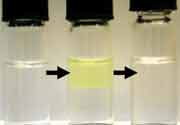Home > Press > Recycling nanoparticles
 |
| Temperature-induced separation and dispersion of cadmium sulphide nanoparticles. Image by Julian Eastoe |
Abstract:
Some nanoparticles are more precious than gold, so being able to recycle them would offer manufacturers important cost savings.
Recycling nanoparticles
UK | Posted on April 28th, 2010Professor Julian Eastoe at the University of Bristol, and colleagues, report the development of a special type of microemulsion - a mixture of oil and water (mayonnaise is an edible emulsion) - that may make it easier for manufacturers to recover, recycle, and reuse nanoparticles.
In laboratory tests using cadmium and zinc nanoparticles, they demonstrate how the oil and water in the microemulsion separated into two layers when heated. One layer contained the nanoparticles that could be recovered and the other contained none.
Importantly, the team reports, the recovered particles retain their shape and chemical properties, which is crucial for their reuse. The new method could speed application of nanotechnology in new generations of solar cells, flexible electronic displays and various other products.
Julian Eastoe said, "Recovering and recycling nanoparticles is especially difficult because they tend to form complex, hard-to-separate mixtures with other substances. We have designed a new kind of solvent which is perfectly suited to nanotechnology.
"A significant advantage of this method over more traditional approaches is that it is much milder on the particles, thereby preserving their structure and stability, and permitting recyclability. Additionally, it allows us to separate and recover the nanoparticles Ďat the flick of a switch', simply by changing the temperature."
This simple process may potentially find applications in cleanup and purification technologies in order to recover, redisperse and reuse valuable nanomaterials. Without this new development, manufacturing processes that take advantage of the unusual properties of nanoparticles might become prohibitively expensive.
The study appears in Langmuir, a bi-weekly journal of the American Chemical Society.
####
For more information, please click here
Copyright © University of Bristol
If you have a comment, please Contact us.Issuers of news releases, not 7th Wave, Inc. or Nanotechnology Now, are solely responsible for the accuracy of the content.
| Related News Press |
News and information
![]() Simulating magnetization in a Heisenberg quantum spin chain April 5th, 2024
Simulating magnetization in a Heisenberg quantum spin chain April 5th, 2024
![]() NRL charters Navyís quantum inertial navigation path to reduce drift April 5th, 2024
NRL charters Navyís quantum inertial navigation path to reduce drift April 5th, 2024
![]() Discovery points path to flash-like memory for storing qubits: Rice find could hasten development of nonvolatile quantum memory April 5th, 2024
Discovery points path to flash-like memory for storing qubits: Rice find could hasten development of nonvolatile quantum memory April 5th, 2024
Academic/Education
![]() Rice University launches Rice Synthetic Biology Institute to improve lives January 12th, 2024
Rice University launches Rice Synthetic Biology Institute to improve lives January 12th, 2024
![]() Multi-institution, $4.6 million NSF grant to fund nanotechnology training September 9th, 2022
Multi-institution, $4.6 million NSF grant to fund nanotechnology training September 9th, 2022
Materials/Metamaterials/Magnetoresistance
![]() Nanoscale CL thermometry with lanthanide-doped heavy-metal oxide in TEM March 8th, 2024
Nanoscale CL thermometry with lanthanide-doped heavy-metal oxide in TEM March 8th, 2024
![]() Focused ion beam technology: A single tool for a wide range of applications January 12th, 2024
Focused ion beam technology: A single tool for a wide range of applications January 12th, 2024
Announcements
![]() NRL charters Navyís quantum inertial navigation path to reduce drift April 5th, 2024
NRL charters Navyís quantum inertial navigation path to reduce drift April 5th, 2024
![]() Discovery points path to flash-like memory for storing qubits: Rice find could hasten development of nonvolatile quantum memory April 5th, 2024
Discovery points path to flash-like memory for storing qubits: Rice find could hasten development of nonvolatile quantum memory April 5th, 2024
|
|
||
|
|
||
| The latest news from around the world, FREE | ||
|
|
||
|
|
||
| Premium Products | ||
|
|
||
|
Only the news you want to read!
Learn More |
||
|
|
||
|
Full-service, expert consulting
Learn More |
||
|
|
||








